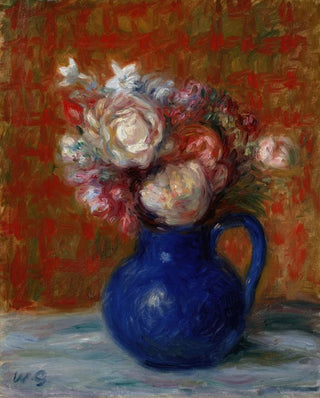Art print | French still life bouquet - William James Glackens


View from behind

Frame (optional)
In the fascinating world of painting, some works stand out for their ability to capture the very essence of life. "French bouquet still life" by William James Glackens is one of those creations that, through its delicacy and intensity, invites the viewer to a profound contemplation. This piece, emblematic of the American Impressionist movement, evokes an atmosphere of serenity and ephemeral beauty. By focusing on color nuances and organic shapes, Glackens manages to transform a simple bouquet into a true celebration of nature. The art print of this work adds a touch of elegance and poetry to any interior, while paying tribute to the artist and his era.
Style and uniqueness of the work
Glackens' style is characterized by a bold and innovative approach to still life, a genre traditionally associated with rigid and formal representations. In "French bouquet still life," the artist chooses to deviate from conventions by adopting a vibrant color palette and playing with light in a subtle manner. The flowers, with their delicate petals and bright hues, seem almost to vibrate on the canvas, giving an impression of movement and life. This dynamism is enhanced by the way Glackens juxtaposes shapes and colors, creating a visual harmony that immediately captures attention. Every detail, from cast shadows to luminous reflections, demonstrates his skill in capturing the nuances of reality, while revealing a personal sensitivity.
The artist and his influence
William James Glackens, a central figure of the American Impressionist movement, managed to leave his mark on his era with a unique artistic vision. Born in 1870, he was influenced by his European contemporaries while developing a style that was entirely his own. Glackens played a key role in introducing Impressionism to America, participating in artistic movements that sought to capture modern life in all its diversity. His work, rich in color and emotion, inspired many artists and helped redefine the perception of still life. By focusing on representing

Matte finish

View from behind

Frame (optional)
In the fascinating world of painting, some works stand out for their ability to capture the very essence of life. "French bouquet still life" by William James Glackens is one of those creations that, through its delicacy and intensity, invites the viewer to a profound contemplation. This piece, emblematic of the American Impressionist movement, evokes an atmosphere of serenity and ephemeral beauty. By focusing on color nuances and organic shapes, Glackens manages to transform a simple bouquet into a true celebration of nature. The art print of this work adds a touch of elegance and poetry to any interior, while paying tribute to the artist and his era.
Style and uniqueness of the work
Glackens' style is characterized by a bold and innovative approach to still life, a genre traditionally associated with rigid and formal representations. In "French bouquet still life," the artist chooses to deviate from conventions by adopting a vibrant color palette and playing with light in a subtle manner. The flowers, with their delicate petals and bright hues, seem almost to vibrate on the canvas, giving an impression of movement and life. This dynamism is enhanced by the way Glackens juxtaposes shapes and colors, creating a visual harmony that immediately captures attention. Every detail, from cast shadows to luminous reflections, demonstrates his skill in capturing the nuances of reality, while revealing a personal sensitivity.
The artist and his influence
William James Glackens, a central figure of the American Impressionist movement, managed to leave his mark on his era with a unique artistic vision. Born in 1870, he was influenced by his European contemporaries while developing a style that was entirely his own. Glackens played a key role in introducing Impressionism to America, participating in artistic movements that sought to capture modern life in all its diversity. His work, rich in color and emotion, inspired many artists and helped redefine the perception of still life. By focusing on representing






